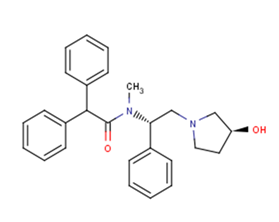
Asimadoline
CAS No. 153205-46-0
Asimadoline( Asimadoline )
Catalog No. M18069 CAS No. 153205-46-0
Asimadoline is a proprietary small molecule therapeutic, originally developed to treat peripheral pain such as arthritis.
Purity : >98% (HPLC)
 COA
COA
 Datasheet
Datasheet
 HNMR
HNMR
 HPLC
HPLC
 MSDS
MSDS
 Handing Instructions
Handing Instructions
| Size | Price / USD | Stock | Quantity |
| 5MG | 60 | In Stock |


|
| 25MG | 267 | In Stock |


|
| 100MG | Get Quote | In Stock |


|
| 200MG | Get Quote | In Stock |


|
| 500MG | Get Quote | In Stock |


|
| 1G | Get Quote | In Stock |


|
Biological Information
-
Product NameAsimadoline
-
NoteResearch use only, not for human use.
-
Brief DescriptionAsimadoline is a proprietary small molecule therapeutic, originally developed to treat peripheral pain such as arthritis.
-
DescriptionAsimadoline is a proprietary small molecule therapeutic, originally discovered by Merck KGaA of Darmstadt, Germany. Asimadoline was originally developed to treat peripheral pain such as arthritis. Asimadoline is an orally administered agent that acts as a kappa opioid receptor agonist. It has shown encouraging clinical efficacy for the treatment of IBS in a barostat study in IBS patients and has the potential for treating other gastrointestinal diseases.
-
In VitroAsimadoline (EMD-61753) has high selectively in κ: μ: δ opioid binding ratios of 1:501:498 in human recombinant receptors. The IC50 for Asimadoline binding to μ-opioid receptors is 3 μM and to δ-opioid receptors is 0.7 μM. The IC50 values for D1, D2, kainate, σ, PCP/NMDA, H1, α1, α2, M1/M2, glycine, 5HT1A, 5HT1C, 5HT1D, 5HT2, 5HT3, AMPA and kainate/AMPA receptors are all >10 μM. Asimadoline has affinity to sodium and L type Ca2+ ion channels at IC50 concentrations 150 to 800 fold the IC50 for the κ receptors. At high concentrations, Asimadoline demonstrates spasmolytic action against 400 μM barium chloride in the rat duodenum (IC50=4.2 μM), suggesting that Asimadoline may block the direct stimulant effects of barium on smooth muscle through mechanisms that are not identified.
-
In VivoAsimadoline (EMD-61753; 1, 5, 15 mg/kg; s.c.) acutely ameliorates both formalin-evoked hyperalgesia and tactile allodynia in diabetic rats.The absorption rate following oral administration is 80% in rats and >90% in dogs and monkeys. The metabolism of Asimadoline is rapid and appears similar in animals and man. Asimadoline has peripheral anti-inflammatory actions that are partly mediated through increase in joint fluid substance P levels. Treatment with Asimadoline (5 mg/kg/day; i.p.) produces marked (and sustained) attenuation of the disease with all three time regimes. Animal Model:Adult female Sprague-Dawley rats Dosage:1, 5, 15 mg/kg Administration:SC; single dose Result:Acutely ameliorated both formalin-evoked hyperalgesia and tactile allodynia in diabetic rats.
-
SynonymsAsimadoline
-
PathwayCell Cycle/DNA Damage
-
TargetDNA/RNA Synthesis
-
Recptorκ opioid
-
Research Area——
-
Indication——
Chemical Information
-
CAS Number153205-46-0
-
Formula Weight414.54
-
Molecular FormulaC27H30N2O2
-
Purity>98% (HPLC)
-
SolubilityDMSO : ≥ 103.3 mg/mL; 249.19 mM
-
SMILESCN([C@H](CN1CC[C@@H](C1)O)C2=CC=CC=C2)C(=O)C(C3=CC=CC=C3)C4=CC=CC=C4
-
Chemical NameBenzeneacetamide, N-((1S)-2-((3S)-3-hydroxy-1-pyrrolidinyl)-1-phenylethyl)-N-methyl-alpha-phenyl-
Shipping & Storage Information
-
Storage(-20℃)
-
ShippingWith Ice Pack
-
Stability≥ 2 years
Reference
1.Camilleri M, et al. Asimadoline, a κ-Opioid Agonist, and Visceral Sensation. Neurogastroenterol Motil. 2008 Sep; 20(9): 971–979.
molnova catalog



related products
-
TH-287 hydrochloride
A potent and selective inhibitor of MTH1 protein with IC50 of 0.8 nM.
-
Apricitabine
Apricitabine (SPD754) is a highly selective and orally active HIV-1 reverse transcriptase inhibitor (Ki=0.08 μM), the (-) enantiomer of 2′-deoxy-3′-oxy-4′-thiocytidine (dOTC) .
-
Pifithrin-μ
Pifithrin-μ is an inhibitor of p53 and HSP70, with neuroprotective and antitumor activity.



 Cart
Cart
 sales@molnova.com
sales@molnova.com


